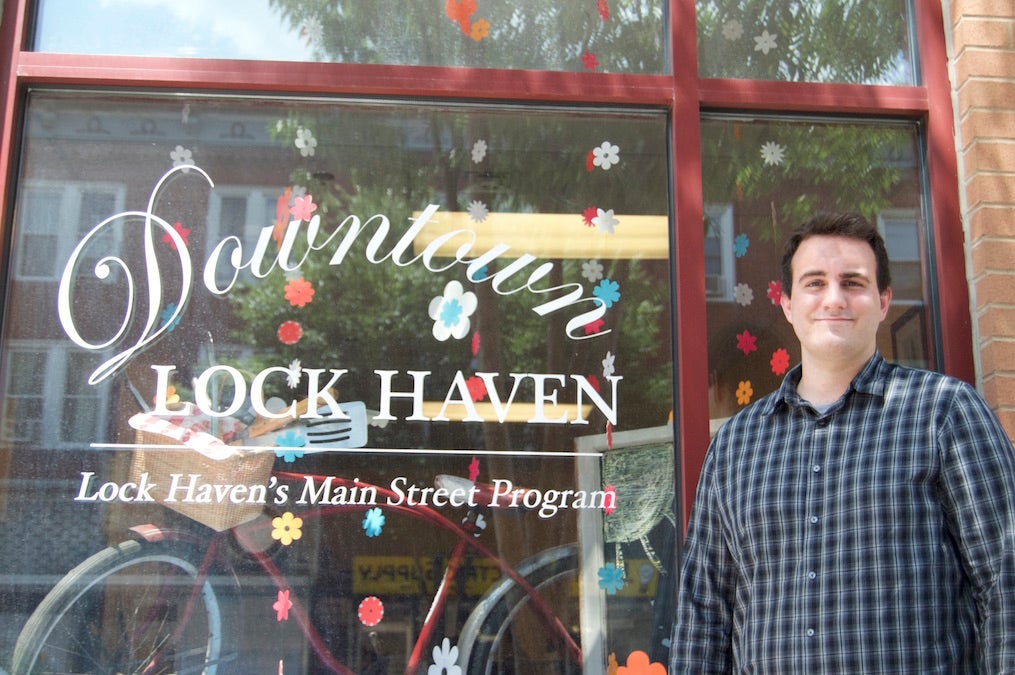Community development ‘internship on steroids’ for Penn State students
Listen
Penn State senior Duncan Ackerman spent the summer documenting vacant space in the city of Lock Haven. (Becca DeGregorio/WPSU)
Students work in cities around the state for the summer.
Duncan Ackerman, a Penn State senior majoring in Community and Economic Development, has spent the whole summer getting to know the store owners in downtown Lock Haven. He rattles off the names of restaurants, hair salons and stores in the small Clinton County town.
“Next to the Texas, we have the Willets Copiers, we have the Masonic Temple … we have Nerd Haven, we have a vacant storefront, then we have Vape Haven.”
Tucked between the comic book store and the e-cigarette shop, it’s the empty storefront that catches Ackerman’s eye. He and two other Penn State students are assembling a list of all the vacant building space in the town’s central business district.
From classwork to fieldwork
They are part of the new Scholarship, Sustainability and Civic Engagement Program at Penn State. This year, 11 students piloted the program, which includes two semesters of classwork and summer fieldwork.
“The spring semester is orientation,” said director Tim Kelsey. “We introduce the students to the community they’ll be working in [over]the summer, we provide them some background training in basic community skills. In the summer, they are in the communities, working with those partners on the project of local need.”
In the fall, they’ll return to campus to reflect on their experiences and mentor the next group of students.
The eleven students are spread across the state, from Philadelphia to the city of New Castle on the Ohio border. And the projects are varied as well. Some groups are working on food access issues, while others apply for tourism grants or document blighted property.
Kelsey says the summer fieldwork is an “internship on steroids.” Students are expected to work independently and produce professional-level results by the end of the summer.
“Our emphasis is equally the student experience but also working on projects defined by the communities that help the communities deal with issues that they are concerned about,” said Kelsey.
Students helping cities
Cities have no shortage of urban development projects on their to-do list. What they’re often lacking is the manpower and financial resources to bring those ideas to life.
That was the case in Lock Haven, a community with a lot of “hidden vacant space” — second floor apartments and unused office space. City Council, the United Way and Downtown Lock Haven, Inc. had all discussed creating an inventory of that space in hopes of attracting new businesses to town.
“We’ve been talking about an inventory for a long time,” said Natasha Gorham, executive director of Downtown Lock Haven Inc. “But this organization only has one full-time staff member, which is myself, and one part-time, so trying to find time to do that along with everything else has been difficult.”
Enter the SSCEP students, willing and eager to get some real-world experience. They are the first cohort, but the program has made a three year commitment to the cities. For the next two summers, a new group of students will build upon the work Ackerman and his peers began this year.
“That’s kinda the one thing that really sold it for me is that this is more long term than just, ‘we’re here for eight weeks and then we’ll leave,'” said Gorham.
Real world lessons
Because, as anyone who works in community development knows, progress can happen very, very slowly. The students learned some important lessons this summer in taking things slow and seeing the value in incremental progress.
“Us being outsiders in the community, it can sometimes be difficult to get a certain level of trust,” said Ackerman. Reaching out to business owners in Lock Haven, he realized that “Their businesses and stores are their livelihoods, and it’s not always easy to talk about that with a stranger.”
When it came to matching academic training with real world skills, there was a bit of a learning curve.
“I was here for their first phone call about setting up the meeting, and I mean, I’m younger myself, so I understand that they were nervous about it,” said Gorham. “But they were so excited, so as long as you come in and you’re open-minded, I think you’ll do great.
She is glad to see fellow young people getting involved in community development, and hopes they’ll stick with it. Ackerman, for one, is ready to go.
“If anything, [this program] has shown me how much more work needs to be done in small communities across America.”
WHYY is your source for fact-based, in-depth journalism and information. As a nonprofit organization, we rely on financial support from readers like you. Please give today.


